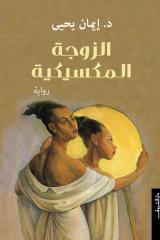Iman Yehia’s The Mexican Wife was on our list of Arab Authors’ Favorites of 2018 and has more recently been longlisted for the 2019 International Prize for Arabic Fiction. This novel tells the story of the great Egyptian novelist Yusuf Idris and his one-time wife Ruth, the real daughter of Diego Rivera:
You published your first novel in your 50s, while in the midst of a completely different career. Were you writing all along, other novels that you did not publish? Or was Writing with the Scalpel your first?


Iman Yehia: My first novel was published when I’d reached 59 years of age. I wrote it all through in only four months! Before writing it, there were some incomplete attempts to write this kind of literature. All these previous attempts failed to reach completion. I read many books dealing with how write a novel, but none of this helped! Suddenly, I passed a critical moment while working in the university hospital, when I found myself in the epicenter of the events. I understood that I was living a real novel. So I wrote it. I think that the accumulation of experiences found in that moment were a way to go outside myself, and thus to be written.
I must say that my career has not changed; I still work as a professor of urology who keeps going in to the university and the hospital. Before writing my first novel, I wrote political articles and studies, and translated several books from Russian and English into Arabic. Perhaps I was so busy with political activities that I had no time to notice my literary tendencies!
Would you have been a different novelist, do you think, if you had started publishing novels in your 20s?
IY: Of course, I would be another person! But if writing at this young age can yield good works, I cannot confirm it. Certainly, passing through many life experiences fills writer’s soul and mind with more completed ideas and deep feelings.
Can you talk about how you first learned that Yusuf Idris had a little-known marriage to Ruth Rivera, daughter of Diego Rivera, and the seven-year journey this sent you on? At what point did you decide to weave it into a fictional narrative — instead of, for instance, a nonfiction work?
IY: First of all, I prefer to use FACTION rather than FICTION.
I read a book about Yusuf Idris by a Soviet Orientalist; it was based on voice records of his testimonies and prototypes of the characters in his works. There, I met a sentence of not more than eight words, such that his novel Al-Beyda’, or The White Woman, was inspired by a first short marriage with Ruth Rivera, Diego Rivera’s younger daughter. From this point began a journey of seeking the truth that went on for more than seven years. I wrote a couple articles about this issue in newspapers, but no one noticed them. Then a crazy good idea popped into my mind—to tell not only the story of love, but also the story of Egypt and the world in early 1950s. Doe the shadows of this story fall on the recent present? Perhaps?
Could you describe a little of the historical research you did for the novel? How did you track down sources in Mexico?
IY: First, through Google searches. I read thousands of pages in English, Arabic, and Russian. I translated from Spanish and French sources. Of course, I found materials from international conferences of peace supporters, and I read the archives of Egyptian communists’ court cases. I read the memoirs of Diego Rivera and Ruth’s mother (Guadalupe Marín, or Gawad Lupp), and Ruth’s son Pedro. The latter is a famous Mexican painter; I got in contact with him. He sent me his mother’s photo in Egypt and confirmed the marriage history.
I met several of Idris’ comrades, who are still alive. It was a long hard adventure, but full of enjoyment. And the journey didn’t stop after publishing the book—some witnesses are now calling me to add new details!
I found it interesting that you said “I wanted the printed book to be a substitute for a film.” What do you mean by that? That you want it to be as exciting as film? To tease as many of the senses?
IY: My first faction was fitting material for a film, but productions and political circumstance did not allow its fulfillment. I decided to make the second faction a real film, with pictures as a part of the text, as well as songs and music, the sites that were the locations of scenes, and even odors. Scenes are the essence of my writing in both novels. In the second one, I used cinematic techniques in the writing and in how it moved between scenes and events. That is what I mean.
You called the novel a “love letter to Yusuf Idris.” You feel he has been under-rated as a writer — locally and internationally? If someone were just coming to Idris, to appreciate his work, what should they start reading? What are your 3-5 favorite works of his?
IY: Truly, I enjoy his works very much. He had a large influence on our generation, and at least two generations before and after me. Yes, he was underrated, perhaps because he was a leftist, and opposed the Egyptian-Israeli Peace Treaty signed by Sadat.
I would advise them to read the short-story collection Cheapest Nights (Arkhas Layali), the play Small Fry (al-Farafir), Dregs of the City (Qa’ al-Madina’), his novel The Sinners (al-Haraam), and the short-story collection The Black Soldier (Al-‘Askary al-Aswad).
Can you talk about the role of photos in the book? It is disappointing that, because of printing costs, you could not embed the photos as you wished within the text. Perhaps in the next edition, you might change them?
IY: The photos were a part of the text, and I did not describe them. They give artistic touches so that the reader can feel their ache and circumstances. It is enough to tell you that this novel could not have been published if I had not found a good picture of Hassan Fouad’s “We Defend the Constitution” poster. The discovery of this old, forgotten poster deserves a whole novel.
Certainly your experience as a doctor shows in Writing with the Scalpel.Do you think your experience as a doctor affected your second novel as well?
IY: No, not at all. I am fond of contemporary history, and I wrote some papers in that field. Also, I spent whole my life in political activities. These experiences were very useful in writing my second novel.
Also read:
Eritrean Novelist Haji Jaber: On Writing the Stories of the Falasha Jews
‘Finally, Haji Jaber’s on an IPAF Longlist’
Habib al-Sayah: Cracking ‘the Shell of the Taboo Around Talking about Algerian Jews’
‘Me and Haim’: an Algerian Odyssey Through Racism
2019 IPAF Longlist Features ‘Strong, Female-led Narratives’
The next interview in this series is forthcoming Saturday, January 26. It’s with Inaam Kachachi, IPAF-longlisted author of The Excluded.
Click HERE to read more from this author.
You can publish this article on your website as long as you provide a link back to this page.

Be the first to comment